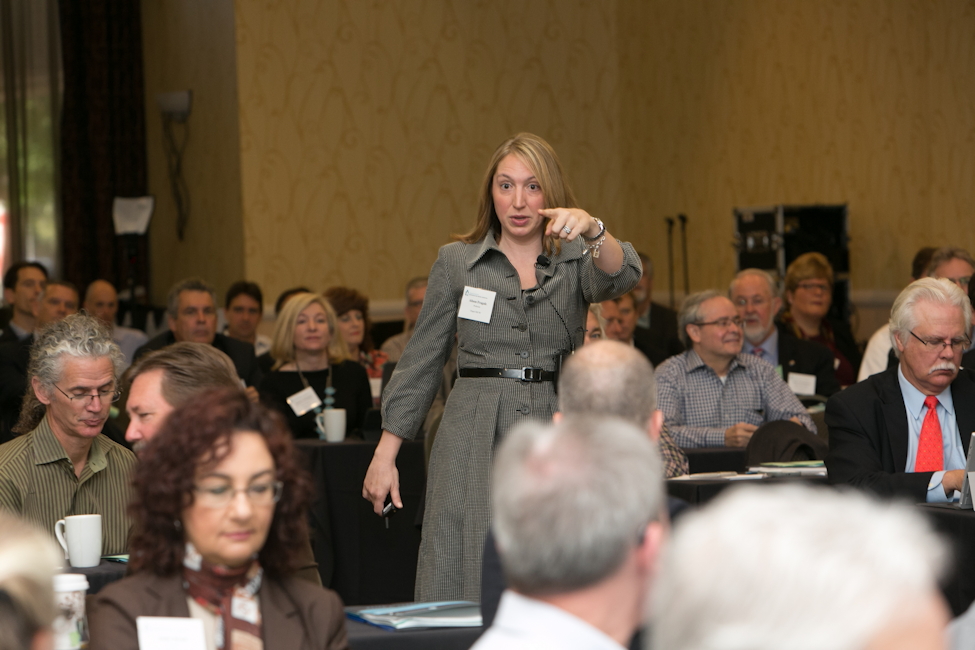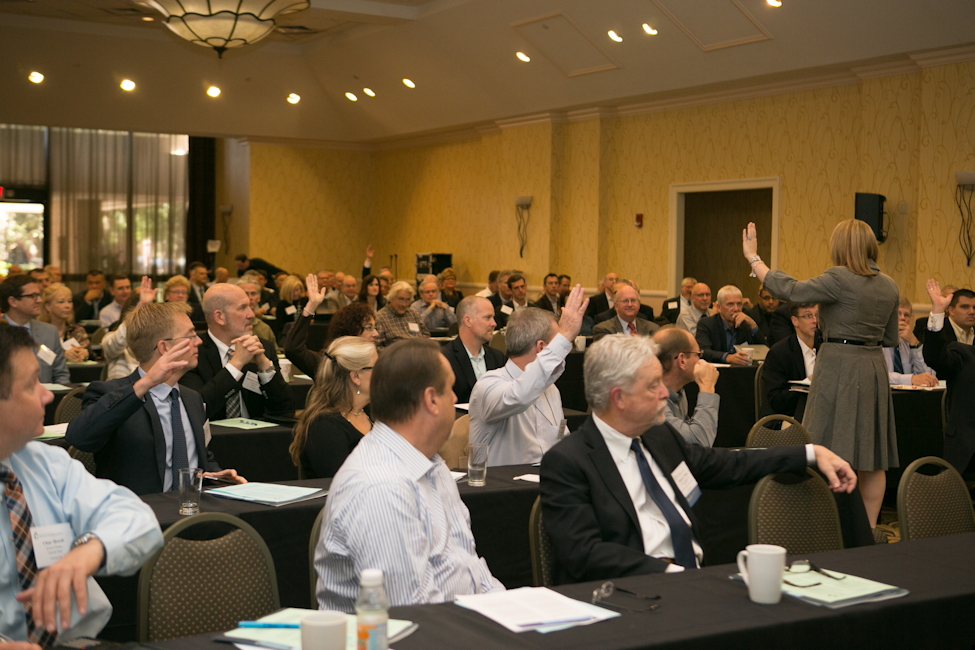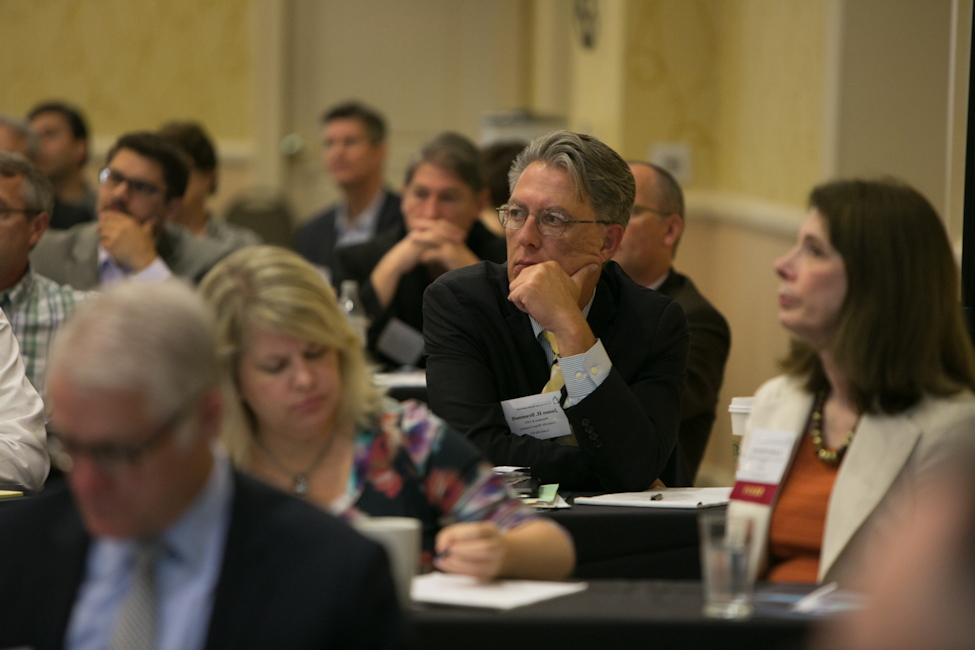Picture more than a hundred water executives in serious, one-on-one negotiations in a single room and you have an idea of how AMWA’s 2015 Executive Management Conference jumped right into its leadership develop ment agenda during the program-launching workshop on Mastering the Negotiation Process. Led by Alison Fragale, professor at the Water and Wastewater Leadership Center and the Kenan-Flagler Business School at the University of North Carolina, the session explored distributive and integrative negotiations, strategies for single issue and multiple issue negotiations and the behavior of effective negotiators – among many practical take-aways.
ment agenda during the program-launching workshop on Mastering the Negotiation Process. Led by Alison Fragale, professor at the Water and Wastewater Leadership Center and the Kenan-Flagler Business School at the University of North Carolina, the session explored distributive and integrative negotiations, strategies for single issue and multiple issue negotiations and the behavior of effective negotiators – among many practical take-aways.
Up next, Dave Rager of Northern Kentucky Sanitation District led a panel discussion on Building Effective Relationships with Elected and Appointed Officials. John Sullivan of the Boston Water & Sewer Commission, Cedric Grant of the Sewerage and Water Board of New Orleans and Kathryn Sorensen of Phoenix Water Services Department discussed politics, maintaining transparency, water rate setting, citizen advisory boards and building credibility.
John Gonzalez of Northeast Ohio Regional Sewer District spoke of the three “must haves” of a utility’s social media: strategy (mission, goals, metrics, messages and methods), system (a reliable combination of policies, platforms and people) and substance (engaging, educating and entertaining). U.S. Water Alliance CEO Radhika Fox provided an update on the work of the Value of Water Coalition, including the Imagine a Day Without Water project, What’s the Value of Water toolkit, initiatives elevating water in the national infrastructure discussion, website resources, robust social media presence and traditional media placement.

In a Q&A session on Lead and Copper Rule revisions, Robert Steidel of the City of Richmond Public Utilities and representative to EPA’s National Drinking Water Advisory Council (NDWAC) Lead and Copper Working Group discussed the group’s draft recommendations, which focus on a program of complete lead service line removal, accompanied by more robust outreach and education as well as revised monitoring and corrosion control requirements. Carrie Lewis of Milwaukee Water Works, who serves on the NDWAC, provided her perspectives as well.
Two AMWA members close to California drought developments – John Rossi of Western Municipal Water District in the south and Jerry Brown of Contra Costa Water District farther north – discussed the unprecedented conditions, water supplies and portfolios, the governor’s executive order, the state board emergency regulations setting mandatory actions by water suppliers, and how each utility dealt with the stringent requirements. Steve Davis of Columbus Water Works walked participants through the 56-party negotiations involved in Forging A Southwest Water Compromise in the Apalachicola-Chattahoochee-Flint River Basin. Rather than relying on lawyers, the group used sound science and collaboration to develop 50 consensus recommendations to improve water resource management and benefit all water users in the system.
From the Department of Homeland Security’s ICS-CERT (Industrial Control Systems-Cyber Emergency Response Team), Neil Hershfield told attendees that cyber threats cannot be eliminated, so cyber risk must be managed. He urged utilities to visit the agency’s website (https://ics-cert.us-cert.gov), join the ICS portal and have an onsite cybersecurity assessment. Clifford Chan, East Bay Municipal Utility District, described how his utility implemented the NIST (National Institute of Standards and Technology) Framework and cybersecurity best practices.
In Seeking a New Customer Service Dynamic, Melanie Rettie of EMA, Inc. gave an overview of traditional customer service and introduced the concept of “experience engineering” that involves advocacy, positive language and anchoring. Ray Hoffman described Seattle Public Utilities’ Easy and Engaged Customer Experience project which involved establishing accurate quantitative indicators of customer effort expended, identifying why customers migrate from web to automated phone to customer representative, and channeling customers to one-stop solutions.
Bill Stowe of Des Moines Water Works spoke on Protecting Surface Waters in Agricultural Watersheds, specifically the impact of nitrate pollution caused by drainage tiling on water quality in central Iowa. He described the issues that led his utility to file a lawsuit against three northwest Iowa counties claiming drainage districts there act as conduits (point sources) for nitrates to move from farm fields into the Raccoon River, one of two sources of drinking water for the Des Moines metro area.
 A panel of utility executives addressed Making Your Buried Assets Last, and James Brammell of Louisville Water described the utility’s condition assessment program. Doug Yoder said Miami-Dade Water & Sewer Department’s assessment includes electromagnetical assessment of PCCP pipe, visual inspection of aerial crossings and televising gravity systems. James Irvin spoke of the benefits of Howard County Public Works’ systematic pipeline management approach. Dan Smith said WaterOne separates transmission pipe and distribution pipe in its pipe risk management strategy because they behave differently, but condition assessment benefits both.
A panel of utility executives addressed Making Your Buried Assets Last, and James Brammell of Louisville Water described the utility’s condition assessment program. Doug Yoder said Miami-Dade Water & Sewer Department’s assessment includes electromagnetical assessment of PCCP pipe, visual inspection of aerial crossings and televising gravity systems. James Irvin spoke of the benefits of Howard County Public Works’ systematic pipeline management approach. Dan Smith said WaterOne separates transmission pipe and distribution pipe in its pipe risk management strategy because they behave differently, but condition assessment benefits both.
PowerPoint presentations from the conference are available at www.amwa.net/presentations.